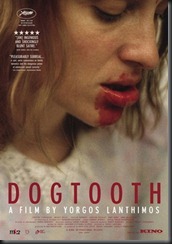Tuesday, April 26, 2011
Psycho: The True Story
Recent female characters
Female characters in our recent movies
Night of the Living Dead - Zombie Commies again!!
Nightmare on Elm Street. - Freddy likes girls more than boys
Monday, April 25, 2011
AL’s Weekly Blog Post #13: Emotional Glaciation; or, the Cinema of Michael Haneke
 In case you are the bizarre person keeping up with the numbering of these posts, then you will notice that number 12 never appeared on the class’s blog page. The twelfth post which concerned the origins and development of slasher and serial killer cinema was almost complete when it was lost due to a virus on my computer. Now Windows is happily reinstalled and virus-free without any data loss other than said blog post. Not to worry—in case
In case you are the bizarre person keeping up with the numbering of these posts, then you will notice that number 12 never appeared on the class’s blog page. The twelfth post which concerned the origins and development of slasher and serial killer cinema was almost complete when it was lost due to a virus on my computer. Now Windows is happily reinstalled and virus-free without any data loss other than said blog post. Not to worry—in case you actually care—said blog post will be recreated from memory, but it will take a little while. For now, I will be posting this shorter analysis and history of Michael Haneke, one of the greatest contemporary filmmakers. Without hesitation, Michael Haneke ranks in my personal top ten filmmakers producing films today—in case you’re interested, my others include Lars von Trier, Wong Kar-Wai, Takashi Miike, Darren Aronofsky, Terrence Mallick, Park Chan-Wook, and others I’m probably forgetting.
you actually care—said blog post will be recreated from memory, but it will take a little while. For now, I will be posting this shorter analysis and history of Michael Haneke, one of the greatest contemporary filmmakers. Without hesitation, Michael Haneke ranks in my personal top ten filmmakers producing films today—in case you’re interested, my others include Lars von Trier, Wong Kar-Wai, Takashi Miike, Darren Aronofsky, Terrence Mallick, Park Chan-Wook, and others I’m probably forgetting.
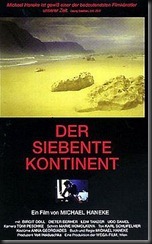 Born in Munich, Germany in 1942, Haneke attended the University of Vienna where he studied philosophy, psychology, and drama. He failed to achieve success in acting or music, and ultimately landed a job as an editor at a German television station. While he had done some work as a television director, Haneke did not make his first theatrical film until 1989 at the age of forty-seven. In 1989, Haneke released The Seventh Continent, the first part of his “Emotional Glaciation Trilogy,” a series of films that explore the alienation and isolation of individuals in the postmodern world. Based on a true story, The Seventh Continent follows the final years of a family that committed suicide together. Although his first film, The Seventh Continent already announced the style and subject matter that would come to define Haneke’s controversial career: a stark, almost clinical aesthetic that
Born in Munich, Germany in 1942, Haneke attended the University of Vienna where he studied philosophy, psychology, and drama. He failed to achieve success in acting or music, and ultimately landed a job as an editor at a German television station. While he had done some work as a television director, Haneke did not make his first theatrical film until 1989 at the age of forty-seven. In 1989, Haneke released The Seventh Continent, the first part of his “Emotional Glaciation Trilogy,” a series of films that explore the alienation and isolation of individuals in the postmodern world. Based on a true story, The Seventh Continent follows the final years of a family that committed suicide together. Although his first film, The Seventh Continent already announced the style and subject matter that would come to define Haneke’s controversial career: a stark, almost clinical aesthetic that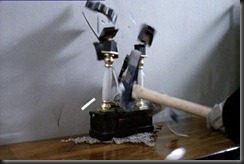 outlines the affectless, alienated lifestyles of its subjects that are punctuated by moments of extreme violence or sexuality. In many ways, Haneke’s aesthetic is about the media—his minimalistic, cinema verite style captures the rare moments of violence and sexuality alongside the quiet hours and days that build towards them. Hence, The Seven Continent follows a seemingly normal and sane middle class family who suddenly cut themselves off from existence, destroy their house and possessions, and then kill themselves. As with the bulk of his films, Haneke’s camera eye never judges the characters—it merely presents their story for our reflection and perhaps even implicates us in their deaths. Ultimately, The Seventh Continent already announces Haneke’s basic thesis that postmodern society has itself become pathological and certifiable.
outlines the affectless, alienated lifestyles of its subjects that are punctuated by moments of extreme violence or sexuality. In many ways, Haneke’s aesthetic is about the media—his minimalistic, cinema verite style captures the rare moments of violence and sexuality alongside the quiet hours and days that build towards them. Hence, The Seven Continent follows a seemingly normal and sane middle class family who suddenly cut themselves off from existence, destroy their house and possessions, and then kill themselves. As with the bulk of his films, Haneke’s camera eye never judges the characters—it merely presents their story for our reflection and perhaps even implicates us in their deaths. Ultimately, The Seventh Continent already announces Haneke’s basic thesis that postmodern society has itself become pathological and certifiable.

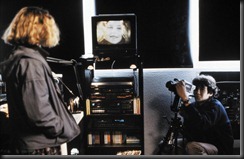 her. Benny shows no remorse for his action nor does he display emotion while committing the murder. The film proceeds to document his and his mother’s response to the crime, but the film’s point is already clear—the real death he
her. Benny shows no remorse for his action nor does he display emotion while committing the murder. The film proceeds to document his and his mother’s response to the crime, but the film’s point is already clear—the real death he  causes seems no different in Benny’s eyes than the ones he see in the news or in films. His entire world is built of simulacra—copies without originals—and hence he can no longer tell the actual from the virtual, the real from the false. Benny’s Video is about the power of video image to mediate and control our experiences of existence. In essence, we no longer believe in anything unless we can watch a video of it. To quote Alex from Stanley Kubrick’s A Clockwork Orange (1971): “the colors of the real world only seem really real when you viddy them on the screen.” Of course, Clockwork Orange is also a film about the controlling power of the image.
causes seems no different in Benny’s eyes than the ones he see in the news or in films. His entire world is built of simulacra—copies without originals—and hence he can no longer tell the actual from the virtual, the real from the false. Benny’s Video is about the power of video image to mediate and control our experiences of existence. In essence, we no longer believe in anything unless we can watch a video of it. To quote Alex from Stanley Kubrick’s A Clockwork Orange (1971): “the colors of the real world only seem really real when you viddy them on the screen.” Of course, Clockwork Orange is also a film about the controlling power of the image.


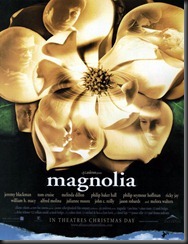 multiple murder that occurs at an Austrian bank, an event announced at the opening of the film. The various fragments of the film ultimately unite in this horrendous act of violence. Haneke cuts to black between each “fragment” and intercuts images from real news footage from Bosnia, Somalia, Lebanon, and other war-torn regions. Again, 71 Fragments examines the violence that permeates ours lives through the media and that can abrupt in random, meaningless ways at any point.
multiple murder that occurs at an Austrian bank, an event announced at the opening of the film. The various fragments of the film ultimately unite in this horrendous act of violence. Haneke cuts to black between each “fragment” and intercuts images from real news footage from Bosnia, Somalia, Lebanon, and other war-torn regions. Again, 71 Fragments examines the violence that permeates ours lives through the media and that can abrupt in random, meaningless ways at any point.
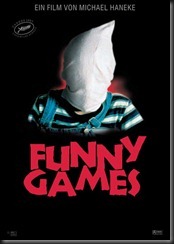 After completing his trilogy, Haneke proceeded to release his most brutal and disturbing film to date: Funny Games (1997), a home invasion narrative that will leave you feeling exhausted from the tension that mounts from the film’s beginning to its very end. Funny Games participates in a long tradition of exploitation films while simultaneously deconstructing them. In my mind, the film recalls Wes Craven’s Last House on the Left (1972), Sam Peckinpah’s Straw Dogs (1971), Meir Zarchi’s I Spit on Your Grave (1978), Ruggero Deodato’s House on the Edge of the Park (1980), and many
After completing his trilogy, Haneke proceeded to release his most brutal and disturbing film to date: Funny Games (1997), a home invasion narrative that will leave you feeling exhausted from the tension that mounts from the film’s beginning to its very end. Funny Games participates in a long tradition of exploitation films while simultaneously deconstructing them. In my mind, the film recalls Wes Craven’s Last House on the Left (1972), Sam Peckinpah’s Straw Dogs (1971), Meir Zarchi’s I Spit on Your Grave (1978), Ruggero Deodato’s House on the Edge of the Park (1980), and many of the other Last House rip-offs. The film also resonates with horror movies that have been released since 1997: David Moreau and Xavier Palud’s Ils (2006; Them) or Bryan Bortino’s The Strangers (2008), which feels like an American remake of the French film but is not stated as such. Haneke’s Funny Games concerns an upper middle-class family who have arrived at their summer house for vacation. Shortly after their arrival, a pair of young men come over ostensibly from their neighbor’s house and
of the other Last House rip-offs. The film also resonates with horror movies that have been released since 1997: David Moreau and Xavier Palud’s Ils (2006; Them) or Bryan Bortino’s The Strangers (2008), which feels like an American remake of the French film but is not stated as such. Haneke’s Funny Games concerns an upper middle-class family who have arrived at their summer house for vacation. Shortly after their arrival, a pair of young men come over ostensibly from their neighbor’s house and  ask to borrow some eggs. But the young duo stay and begin torturing the family of three or playing games with them as the young men term it—we never receive the duo’s real names: they alternately call each other Peter and Paul, Tom and Jerry, and Beavis and Butthead. Featuring no non-diegetic sounds or music except during the opening and closing credits, Funny Games is an unrelentingly realistic serial killer film that almost never depicts acts of violence or depravity but instead builds its almost unbearable tension through the emotions of the characters, the camerawork, the silence of its soundtrack, and extreme long takes that
ask to borrow some eggs. But the young duo stay and begin torturing the family of three or playing games with them as the young men term it—we never receive the duo’s real names: they alternately call each other Peter and Paul, Tom and Jerry, and Beavis and Butthead. Featuring no non-diegetic sounds or music except during the opening and closing credits, Funny Games is an unrelentingly realistic serial killer film that almost never depicts acts of violence or depravity but instead builds its almost unbearable tension through the emotions of the characters, the camerawork, the silence of its soundtrack, and extreme long takes that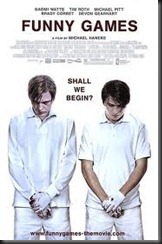 force the viewer to endure the horror and sorrow of the victims in real time. Funny Games continues to develop Haneke’s distinctively objective and clinical style of filmmaking, but it adds a new twist by having the characters break the fourth wall repeatedly by winking at and even talking to the audience. Ultimately, such moments make us the viewer complicit in the horrors we watch unfold, horror spectacles that Haneke actually denies us by having them occur off-screen in complete defiance of what most horror fans expect. The film ultimately poses a series of questions to us the viewers: “Why the FUCK are you watching this? What is wrong with you and our media society that such a film would be produced and be watched by you? Why do you want to see others suffer? Have you no empathy? Have you no emotions?” And
force the viewer to endure the horror and sorrow of the victims in real time. Funny Games continues to develop Haneke’s distinctively objective and clinical style of filmmaking, but it adds a new twist by having the characters break the fourth wall repeatedly by winking at and even talking to the audience. Ultimately, such moments make us the viewer complicit in the horrors we watch unfold, horror spectacles that Haneke actually denies us by having them occur off-screen in complete defiance of what most horror fans expect. The film ultimately poses a series of questions to us the viewers: “Why the FUCK are you watching this? What is wrong with you and our media society that such a film would be produced and be watched by you? Why do you want to see others suffer? Have you no empathy? Have you no emotions?” And  the killers actually pose an equally provocative question at one point in the film: who do root for in the film? The killers or the victims? Funny Games is an absolutely brilliant exploration of our obsession with violence and tragedy and the media’s portrayal of it. And none of us are innocent—we help create the crimes and tragedies that unfold upon our television. Haneke so loved Funny Games that he directed an almost shot-for-shot, English language remake of the film that was released in 2007—the tenth anniversary of the original. In many ways, Funny Games can’t help but remind me of Tool’s song “Vicarious,” which concerns our need to experience violence and death through the media—see below for the video.
the killers actually pose an equally provocative question at one point in the film: who do root for in the film? The killers or the victims? Funny Games is an absolutely brilliant exploration of our obsession with violence and tragedy and the media’s portrayal of it. And none of us are innocent—we help create the crimes and tragedies that unfold upon our television. Haneke so loved Funny Games that he directed an almost shot-for-shot, English language remake of the film that was released in 2007—the tenth anniversary of the original. In many ways, Funny Games can’t help but remind me of Tool’s song “Vicarious,” which concerns our need to experience violence and death through the media—see below for the video.

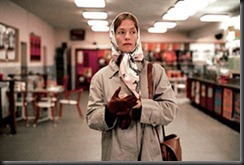 between the two. Featuring Haneke’s trademark clinical, unsympathetic style, The Piano Teacher includes clips from hardcore pornography and pushes the boundaries of cinematic depictions of fetishism. A powerful film about the forces that control us and the obsessions that drive us, The Piano Teacher may not be as traumatic as some of Haneke’s previous films, but it still slowly sculpts a growing sense of unease and despair in the viewer as we glimpse the truly fractured nature of the human psyche.
between the two. Featuring Haneke’s trademark clinical, unsympathetic style, The Piano Teacher includes clips from hardcore pornography and pushes the boundaries of cinematic depictions of fetishism. A powerful film about the forces that control us and the obsessions that drive us, The Piano Teacher may not be as traumatic as some of Haneke’s previous films, but it still slowly sculpts a growing sense of unease and despair in the viewer as we glimpse the truly fractured nature of the human psyche.
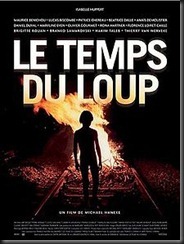 Haneke followed up The Piano Teacher with The Time of the Wolf (2003), a post-apocalyptic tale concerning a family trying to survive in a steadily decaying and dangerous world. Like Cormac McCarthy’s The Road (2006), Time of the Wolf never reveals the cause of the world’s devastation but instead focuses upon the human need to survive in the absence of society—it is powerful film about the ties that bind us together and help us cope with reality. Reminiscent of Thomas Hobbes’s Leviathan, the film ultimately questions whether humanity can exist in the absence of social order or whether we will
Haneke followed up The Piano Teacher with The Time of the Wolf (2003), a post-apocalyptic tale concerning a family trying to survive in a steadily decaying and dangerous world. Like Cormac McCarthy’s The Road (2006), Time of the Wolf never reveals the cause of the world’s devastation but instead focuses upon the human need to survive in the absence of society—it is powerful film about the ties that bind us together and help us cope with reality. Reminiscent of Thomas Hobbes’s Leviathan, the film ultimately questions whether humanity can exist in the absence of social order or whether we will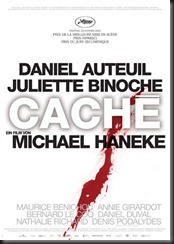 slowly devolve back into nothing more than overly complicated beasts. Haneke returned to realistic cinema with contemporary settings in his acclaimed thriller Cache (2005; Hidden). Cache starts off like David Lynch’s Lost Highway, which we watched earlier this semester: a couple begins receiving mysterious tapes of themselves. The tapes ultimately lead the couple into a thrilling series of investigations that may open up forgotten or repressed aspects of their pasts. Haneke’s penchant for long takes and static camerawork reaches its apex in Cache with its frequent inclusion of supposed surveillance camera footage.
slowly devolve back into nothing more than overly complicated beasts. Haneke returned to realistic cinema with contemporary settings in his acclaimed thriller Cache (2005; Hidden). Cache starts off like David Lynch’s Lost Highway, which we watched earlier this semester: a couple begins receiving mysterious tapes of themselves. The tapes ultimately lead the couple into a thrilling series of investigations that may open up forgotten or repressed aspects of their pasts. Haneke’s penchant for long takes and static camerawork reaches its apex in Cache with its frequent inclusion of supposed surveillance camera footage.
Haneke’s most recent film, The White Ribbon (2009), was his first black and white film and his first to win the Palm d’Or at The Cannes Film Festival. A hauntingly beautiful and disturbing depiction of a German village on the cusp of World War I, the film concerns the puritanical education of the village’s children and their often inhumane punishment. On a more general level, it concerns the disturbing and violent events that are occurring beneath the seemingly placid, 
The same year as The White Ribbon also saw the release of an absurdist Greek drama that participates in a similar style to Haneke. Yorgos Lanthimos’s Kynodontas (2009; Dogtooth) concerns a family that has kept its three, now adult children from the outside world—they are not allowed to travel beyond their house’s gates until they have lost their dogteeth. The parents have taught their children that words means different things than they do in reality, and the father pays a young woman from work to come into the house and have sex with the son. A powerful examination of the human need for communal engagement and perhaps an indictment of home schooling, Dogtooth examines the way in which society structures our identity and understanding of reality. A brutal and unforgettable film, Dogtooth will make you reconsider even the most basic things that you have been taught—it is a excoriating deconstruction of education and family that will leave you unsettled by the time the credits roll.
examination of the human need for communal engagement and perhaps an indictment of home schooling, Dogtooth examines the way in which society structures our identity and understanding of reality. A brutal and unforgettable film, Dogtooth will make you reconsider even the most basic things that you have been taught—it is a excoriating deconstruction of education and family that will leave you unsettled by the time the credits roll.
Sunday, April 24, 2011
Nightmare on Elm Street
Inspired by True Events??? Really?
“Inspired by true events” is a phrase commonly seen at the beginning of serial killer flicks. But, I always wonder just how “true” these events are? I think the phrase can often be misleading, but it ultimately makes the audience’s experience scarier knowing that these things could have happened like this in the real world. The serial killer Ed Gein provided inspiration for the leading creeps in “Psycho,” “Texas Chainsaw Massacre,” and “Silence of the Lambs.” Only small details from Ed Gein’s horrific murders are used as inspiration. In the case of “Texas Chainsaw Massacre,” the special edition DVD of the remake has a very interesting documentary-like spill in the special features all about Gein and his killing spree in Wisconsin.
“The Strangers” (2008) is a newer film that is “based on true events” but these events are disappointing when you consider the horrific actions in the movie. For those of you who have not seen it, “The Strangers” follows a couple, on the rocks, who stops to stay the night at a cabin on the way back from a friend’s wedding. Upon arriving, they are greeted and ultimately tortured by strangers. The scariest part of this film (at least for me) is that the killers have no motive at all, just boredom. Also, the entire movie is built on suspense. The killers parole the perimeter of the house (and sometimes the inside of the house) and leave creepy messages on the doors and windows. After I saw this movie, I immediately started searching for the story that inspired the plot. I was disappointed to find that the film was based partly on the Manson murders, 1981 Kedie Cabin killings in Sierra Nevada’s, and partly on an “event” that happened to the director as a kid.
“As a kid, I lived in a house on a street in the middle of nowhere. One night, while our parents were out, somebody knocked on the front door and my little sister answered it. At the door were some people asking for somebody who didn't live there. We later found out that these people were knocking on doors on the area and, if no one was home, breaking into the houses,” – Bryan Bertino, director.
These scary real-life stories have been made into some terrifying films over the years. However, it still bothers me how loosely directors throw around "inspired by true events” or “based on a true story.” How can they honestly put these labels on films that are basically straight fiction? My verdict is that it just straight up makes the movies scarier when you know they are “real.”
Saturday, April 23, 2011
Nightmares
Thursday, April 21, 2011
Funny Games
Sunday, April 17, 2011
Slasher films
I suppose these movies seem more real to me than science fiction or zombie thrillers that contain more obviously fantastical creatures that are known not to exist, rather than a normal human whose psychological processing has been interrupted by some traumatic but plausible event that has caused them to respond with a gruesome rampage. Perhaps these films engage with some of our deepest, most twisted fears in order to convince us that such sick individuals are out there and perhaps just a step away with every creak in our homes and rustle in the bushes.
Black Christmas
Suspense in Black Christmas
The film also combines a series of claustrophobic shots, especially when introducing the killer. Clark films him in fragments to add mystery to his character and reveal his fragmented mind. We never see his face completely, but instead we're often trapped in his point of view, which often originates in a closet or a tight space. While the drama unfolds at night, adding an even greater sense of foreboding, Clark uses every angle and inch of space in his shots to conjure suspense and surprise.
This was the first film all semester where I truly felt on the edge of my seat and surprised by what was to come. A movie about a serial killer in a sorority house could have been painfully predictable, but I think Clark's techniques in creating suspense and anxiety among viewers is genius.
1, 2 Freddy's Coming for You
Ironically, what I find most evil about Freddy is his sense of humor. He is truly sadistic and not a homicidal child trapped in a man's body or a gender confused Oedipal character. His humor shows his true joy in killing and torturing his victims. We've already seen him take one victims life, but this is yet the first to come. In that first killing sequence we saw both his sheer viciousness and his comedic taunting of his victim just for the sake of seeing him or her in fear. Freddy is evil. Freddy is the boogeyman.
Saturday, April 16, 2011
Psycho and Taboos
That being said, Psycho is as classic a film today as it was edgy for the time. I’ve seen a number of Hitchcock films but I cannot recall in any of them the female characters walking around half-dressed or lying in bed with their boyfriends. The film can be dated by the language and elements that were seen as “racy” at the time. You don’t ever see Janet Leigh’s navel- that would have been a no-no until I Love Jeannie eventually forced the taboo out. I even discovered through the magic of the Internet that the flushing of the toilet was even taboo at the time.
I wasn’t familiar with the “sequels” to the Psycho film until Wikipedia directed me to them. In these sequels Anthony Perkins return as Norman Bates, commits more murders, but all because “Mother” has come back into his psyche and taken over. The sequels, instead of incriminating Bates, try to make the audience sympathize with him. Perhaps in the decades that followed the original, when the sequels were made, there was not only a greater understanding of mental illness but sympathy for people with those conditions.
Night of the Living Dead and Race
Psycho and Slasher Film
Any slasher film that preys on the idea of when the real life audience are the most vulnerable have a higher chance of actually being terrifying compared to those that continuously put a group of kids in the woods only to be chopped up by some deranged and child abused killer. When done the right way, a small scene that targets our most basic fears (killer under the bed, noises in the house)are the biggest nightmare to the audience because they start out with an element of the unknown. The fact that the first viewing audiences of Psycho did not know that Norman was both the killer and his mother was doubly terrifying because it forced them to deal with the idea that a normal perception of behavior could also serve as a phsychotic one. That we may never know the type of people we actually surround ourselves with. Those slasher films that can leave the audience still questioning after the film will always be transcendent of the rest.
Slasher Films and Psycho
As I’ve stated in earlier posts, the horror genre has never been high on my list due to its generally graphic content and its dependency on fright as its primary entertainment value. Nonetheless, as we progress through this section of the class I am finding less and less trepidation when it comes to several of these films. Take, for instance, the subcategory of slasher films. Despite their gory nature, I have come to find them quite predictable due to the limited realm of deathly techniques at the killer’s disposal. Additionally, there is often a comical nature associated with the characters, as though the characters know of their impending doom and the director is making morbid jokes about their inability to survive. In fact, the latest Scream sequel’s television trailer boasts that the film is “hilarious” among other adjectives describing the horrific elements of the film.
I had a similar impression when watching the original cut of Psycho for the first time. As with many of the early films we have watched, the film is comical in what it considers racy, which is almost G-rated in today’s society. However, placing myself in the timing of the film’s release, I can understand how it has developed into a timeless classic. The plot of the movie is genius in the fact that it throws viewers off by killing off the supposed protagonist midway through the film. This throws off the audience to think that perhaps the prior 40 minutes of plot were meaningless.
Additionally, Hitchcock focuses on the psyche of the murderer rather than his actual killings. Thus, the film succeeds where many modern slashers stumble. Rather than inundating viewers with graphic kill after graphic kill, the murderer only successfully kills two characters off during the movie. Nonetheless, by developing the insanity of the character, Hitchcock develops a much scarier character than any mass murderer. The audience sees how and why the killer is so disturbed, earning him empathy and an element of realism. Instead of killing him off at the end of the film, Hitchcock allows the insanity to end the film. Thus, rather than feeling safe and secure that the killer is dead and out of their minds, Psycho’s audience is left to dwell on the madness of the killer and to cope with the understanding that insanity of that nature could exist in the real world.
Killer Clowns and Skull Ashtrays

...and Ed Gein (caught in the late '50s), who was probably Wisconsin's most notorious serial killer before Jeffrey Dahmer came along in the '90s. Here's a short documentary about Ed, who was part of Hitchcock's inspiration for Psycho. Ed, who also had mommy issues, used to gut people like deer and use their skins and skulls to make furniture, lampshades, ashtrays, etc. He was handy like that.
I'm not sure how familiar people are with Jeffrey Dahmer anymore, but he started murdering folks in the '70s and wasn't caught until the mid '90s. He lived in my hometown, frequented a couple of the same bars I used to go to, and looked creepily familiar when I first saw his picture on the news. My best friend's dad was one of the cops on the scene when the remains of his victims were found in the guy's apartment. The stench was unbearable, and he has no idea why the neighbors never complained.
So anyway, my point is that serial killers are something you hear about all the time, so they pack the biggest scare punch for me. This film from 1990, Henry:Portrait of a Serial Killer, is probably one of the most realistic, frightening, and well-made serial killer films you'll ever see:
I saw it at a 10pm showing when it came out, and I had to walk home alone afterward, which was very poor planning indeed.
On a lighter note, here are trailers from a couple of my all-time favorite deranged killer B-movies. Both are brilliant.
In Two Thousand Maniacs! (1964) some young Yankee travelers are lured into a southern small town that isn't always there, and the townspeople convince them to join them for a centennial celebration they are throwing. Then the Yanks are all killed one-by-one in extremely inventive ways--some of which include festival games that the whole town participates in. It is awesome and has the best soundtrack since Lawrence of Arabia.
In Spider Baby (1968), distant relatives come to visit three orphaned children who are being cared for by the family chauffeur (played by Lon Chaney Jr.). The kids have some weird disease that causes evolutionary regression. Gore ensues.
Oh...and on a lighter lighter note, here's my all-time favorite black comedy, Parents (1989), in which a kid in a seemingly idyllic 1950s family learns that his parents are extremely twisted individuals.
Sleep tight, all.
Psycho shower

Alfred Hitchcock’s “Pyscho” was one of the best horror films I have seen in a very long time. It had everything a movie of this genre should have; there was gore in the shower, an interesting plot line, and a great twist at the end. It kept me on the edge of my seat the entire movie. I have to say the shower scene was one of the greatest murder scenes I have seen in a horror film. You already felt very creeped out because Norman was watching her undress through his hole in the wall. Then, as you suspect that maybe everything will be alright, the creepy shadow appears from behind the curtain, further incriminating his “mother.” The blood being in black and white was much more believable than most color films I have seen. All of the chunks that you see floating down the drain were more than enough to make me feel queasy. After watching this film I felt afraid to take a shower for a few days, I locked my door to make sure no murdering mothers would enter.
Unfulfilling Christmas
That being said, the movie was so-so. It was quite corny but it definitely had its moments of shock value. The relationship between Jess and her boyfriend was a well-thought-out commentary on the progressive role of women during this era, but again I was disappointed that it concluded so senselessly. Aside from the progressive social commentary which I give this movie credit for, I really didn't enjoy how unrealistic it was. Slasher films have never been on the top of my list for this reason. Stupid, irrational characters just make me angry and annoyed because I know that people are not quite that dumb in real life. I like some realism in my films!
Black Christmas:
I have to admit that I was expecting for the women in Black Christmas to be shown in an even worse light than perhaps they were. Not sure why, but when I saw that the movie was going to take place in a sorority house I expected for the girls to be shown running around in their underwear, having pillow fights, and having sex with their boyfriends. Instead the girls kept their close on, yes they drank a lot but I almost felt that was a statement about the time. I saw the movie as showing what they believed college life was like at the time. The students were shown as drinking heavily and there is no mention of going to class or taking exams (even though it was close to the holiday). I was even impressed with the posters that were shown in the girl’s room. The posters had nudity and I found this extremely funny because most people would see that as “un-lady like”.











